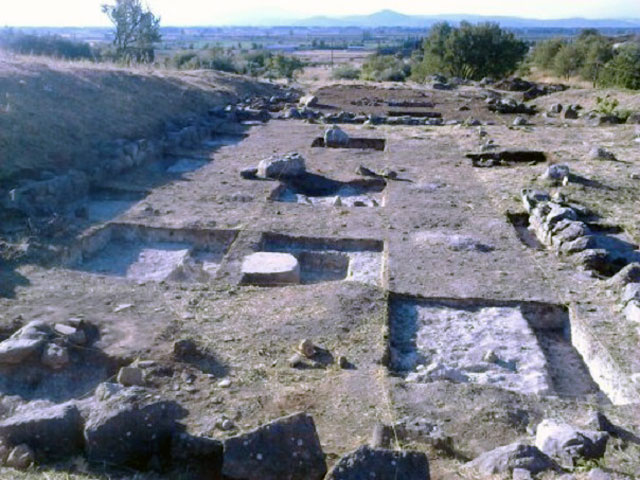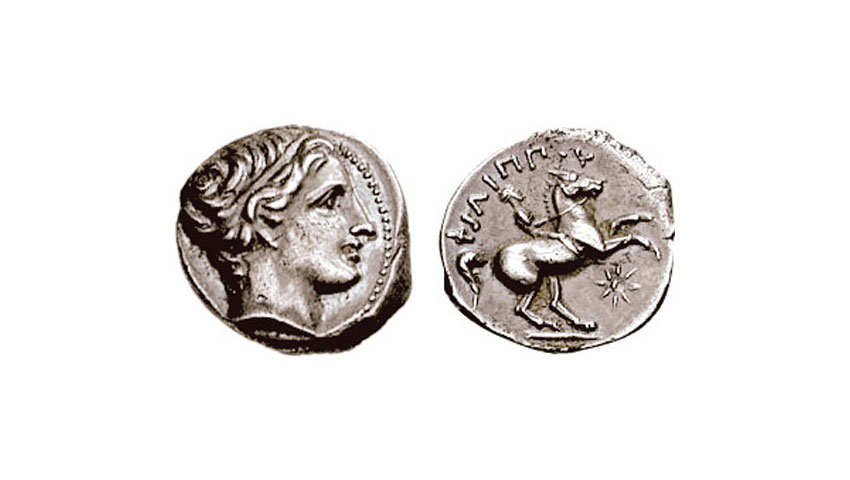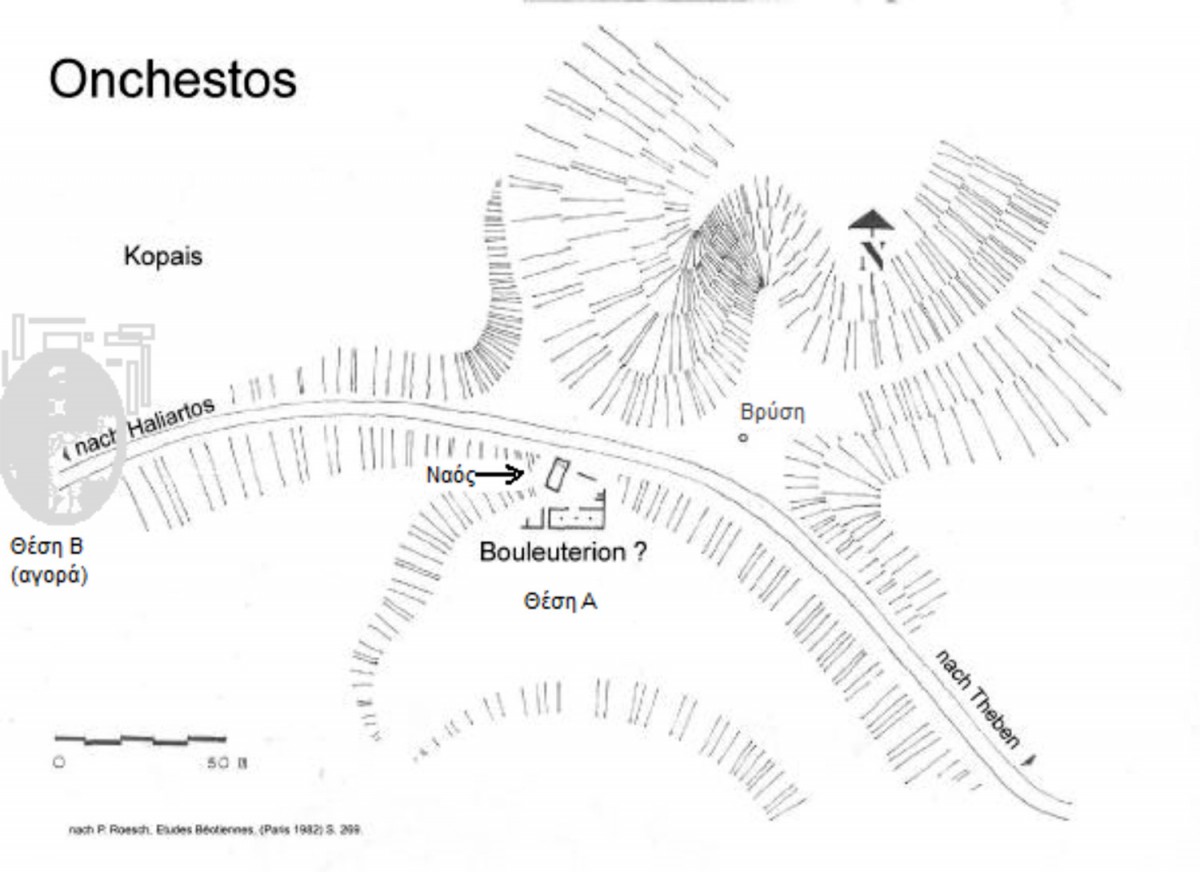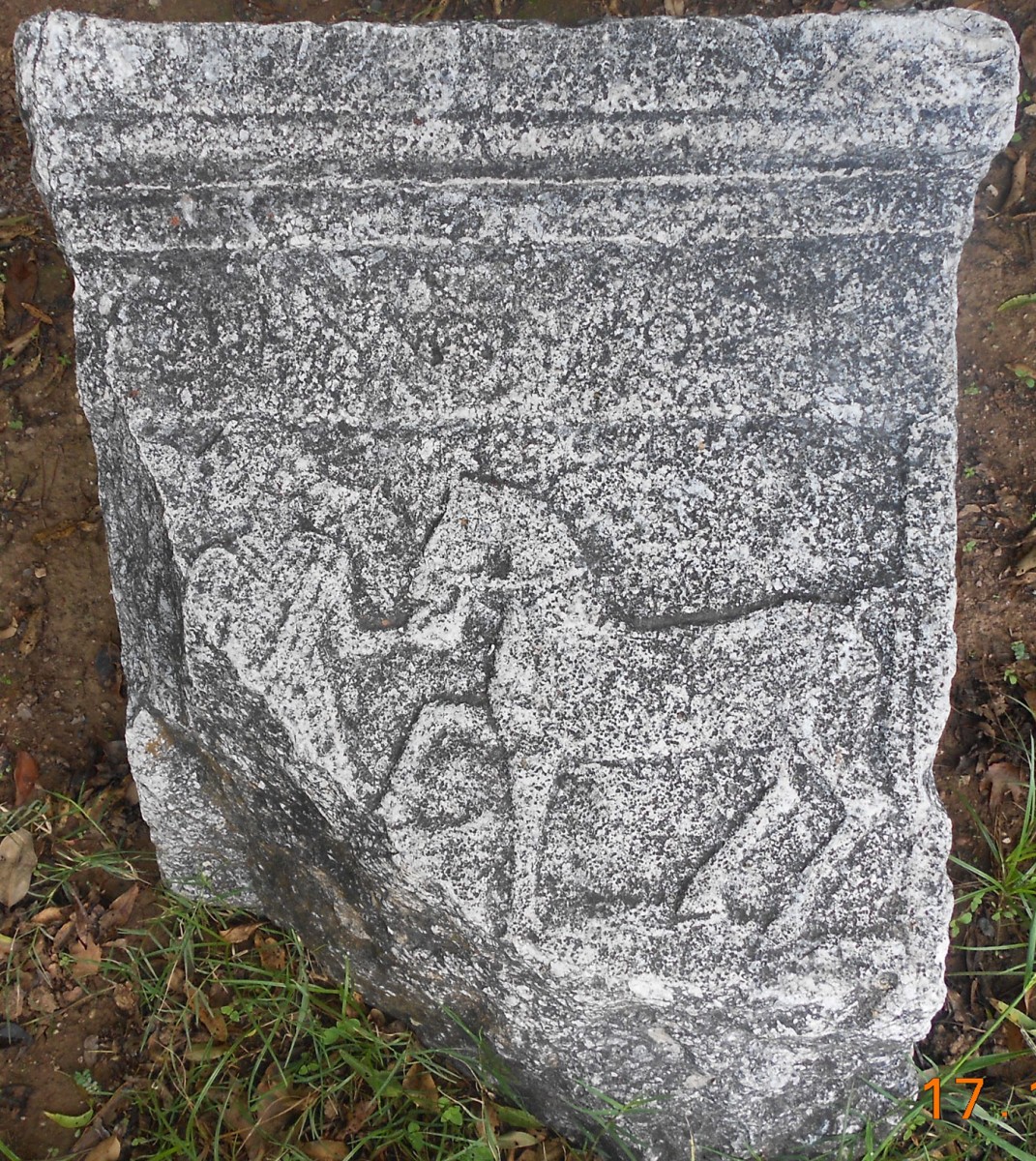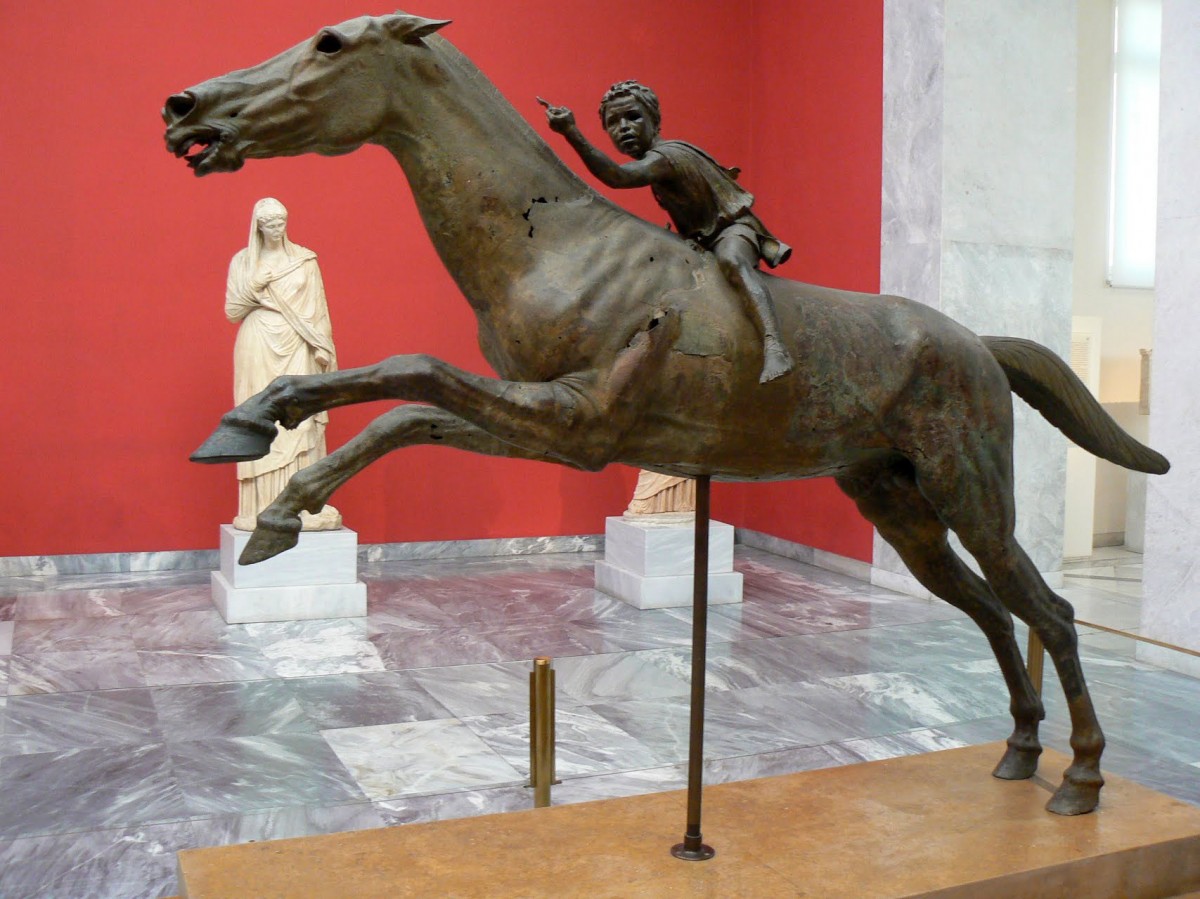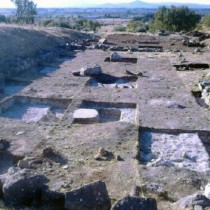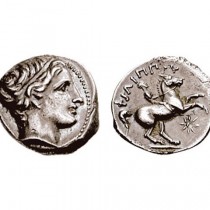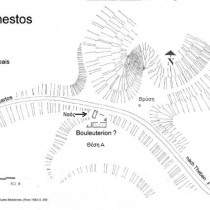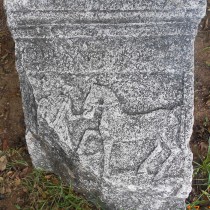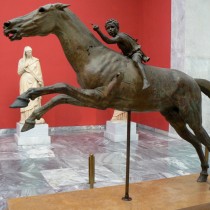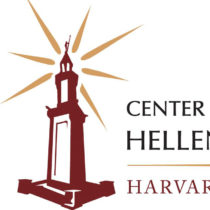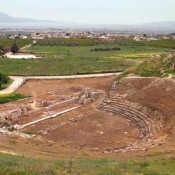The sanctuary in Onchestos is one of the most ancient in Greece referred to by name in Rhapsody B of the Iliad and specifically in “The Catalogue of Ships” («Νηών Κατάλογος»). Several archaeologists have come to the conclusion that the world appearing in this catalogue describes conditions of the Late Helladic period (note 1). According to Apollodorus (note 2) and Pausanias (note 3), chariot races in honour of Poseidon took place in Onchestos, already in the era preceding the Trojan war, with the participation of the Minyes of Orchomenos and the Thebans.
Onchestos, whose site was consecrated to Poseidon, was the seat of one of the most ancient Amphictyonic Leagues (note 4). It is in fact believed that in the Mycenaean era there must have been an open air shrine on the site (note 5) which, apart from the religious ceremonies it hosted, was also linked with vital interests of the area’s authorities, due to its exceptional position on the narrow pass controlling the main road towards Delphi (note 6).
Reference to the sanctuary in the “Homeric Hymn to Apollo” is particularly important, in which a strange ritual is described, in honour of Poseidon and involving charioteers. Despite this hymn being of doubtful origin, nevertheless scholars believe (note 7) that its poet must have been from Boeotia, since he names the towns and topography from east to west, according to Apollo’s route to Delphi, with great precision.
Based on these references, as well as on challengesfrom the latest excavations in Onchestos’ archaeological site, we shall try to present this type of cult, known as the “Onchestia” (note 8), so as to proceed with our previous study (note 9).
Useful archaeological data
The site of Onchestos seems to have been inhabited from Prehistoric times (note 10), while the first rescue excavations undertaken by archaeologists Evi Touloupa (note 11) and Theodoros Spyropoulos (note 12) brought to light a section of the sanctuary of Poseidon in the site known as A, situated on the 91st klm of the Thebes-Livadeia National Highway. Architectural members of a large rectangular building were also unearthed with three stone bases of columns in its interior, probably the Council chamber (Βουλευτήριο) for the Boeotian Koinon (Κοινό) and a hall with pillars, perhaps for assemblies, both dating from the 2nd half of the 6th c BC.
Excavations carried out at site B, one kilometer to the west, by archaeologists Alexandra Christopoulou (note 13) and Fanouria Dakoronia (note 14) brought to light a section of a large colonnade complex, dating from the end of the 4th c BC and thought to be an agora, which was surrounded by Πshaped colonnades with an area of 2.4 acres and attached to the shrine. According to the excavators, its existence wasjustified by the sanctuary’s possible function as a political and religious centre of the Boeotian Koinon i.e. it catered to a variety of needs (administrative, political and religious) of the Boeotian Federation. Bintliff and Snodgrass are of a different opinion, arguing (note 15) that this large area was a fortified settlement of Onchestos, formed in the Hellenistic era. This theory has not been confirmed, however. In June 2014, a new five year excavation-research programme began in Onchestos, under the auspices of the Archaeological Society in Athens headed by Alexandra Harami, director of the Ephorate of Boeotian Antiquities and headed on behalf of the Archaeological society by Ioannis Mylonopoulos, professor of Classical Archaeology at the University of Columbia (note 16). The first preliminary results were published by Vasileios Petrakos, Secretary General of the Archaeological Society (note 17) and shown by professor Mylonopoulos at a brief presentation (note 18).
At site A, an extension of the excavation (fig. 1) revealed new archaeological remains of the Early Hellenistic period as well as many moveable finds (note 19), from which metallic parts of harnesses stand out and a large number of coins from Lokris, Sikyon, the Kingdom of Macedonia et al., suggesting both the dynamics and the importance of the sanctuary of Onchestos at a national level. In our case, the discovery of a bronze Macedonian coin is especially important (note 20), depicting the head of Apollo on its obverse side, while on the reverse, a galloping horseman is shown holding the reins and bearing the inscription ΦΙΛΙΠΠΟΥ (fig. 2).
Fresh research also extended to the area of the agora (site B), where magnetic surveys in conjunction with excavation trenches confirmed the existence of more buildings and particularly a “huge circular edifice with a diameter of at least 40 meters, whose function has yet to be explained” (note 21). This great circular construction, unlike anything else in antiquity, as stressed by the excavator, covers part of today’s road leading to Onchestos and is linked to the place being used for worship. Namely, the view of previous excavators was confirmed that the agora was directly linked with the sanctuary of Poseidon, that “sites A and B belong together” (note 22).
We shall make use of this archaeological data combined with written sources, in our attempt to introduce the place where religious events were held in honour of Poseidon, as well as presenting their specific features.
The charioteers in the Homeric Hymn and its different interpretations
The poet of the Homeric Hymn to Apollo presents an unusual ritual carried out by charioteers in “Poseidon’s precinct in Onchestos” («ἐν᾿ΟγχηστῷΠοσειδῶνοςτεμένει»)(note 23). Specifically in lines 225-238 this event is described as follows
ἔνθεν δὲ προτέρω ἔκιες, ἑκατηβόλ’ Ἄπολλον,
Ὀγχηστὸν δ’ ἷξες, Ποσιδήιον ἀγλαὸν ἄλσος: (230)
ἔνθα νεοδμὴς πῶλος ἀναπνέει ἀχθόμενός περ
ἕλκων ἅρματα καλά: χαμαὶ δ’ ἐλατὴρ ἀγαθός περ
ἐκ δίφροιο θορὼν ὁδὸν ἔρχεται*: οἳ δὲ τέως μὲν
κείν’* ὄχεα* κροτέουσι ἀνακτορίην ἀφιέντες.
εἰ δέ κεν ἅρματ’ ἀγῇσιν ἐν ἄλσεϊ δενδρήεντι, (235)
ἵππους μὲν κομέουσι*, τὰ δὲ κλίναντες* ἐῶσιν:
ὣς γὰρ τὰ πρώτισθ’ ὁσίη γένεθ’: οἳ δὲ ἄνακτι
εὔχονται*, δίφρον δὲ θεοῦ τότε μοῖρα φυλάσσει.
(Translation by Hugh G. Evelyn- White and this translator from the paper’s modern Greek translation): “And then you left there (meaning: Thebes), O far shooting Apollo, and came to Onchestos to the bright grove of Poseidon. There the newly tamed colt finds its breathe again even though burdened by drawing the fine chariots and the brave charioteer springing from his seat goes on foot. And then the colts draw the vehicles along noisily being left without guidance. And if the chariots are broken to pieces in the wooded grove, men look after the horses but leave the chariots behind. Because this is how this sacred custom was from the start. There the charioteers pray to the lord of the shrine (Poseidon) and the chariot is left to the lot of the god.”
Since the 17th c., this passage had already been analyzed by many scholars who interpreted it in various ways. The first interpreters (note 24) supported its religious nature with variations, however, though most of them understood this strange custom as a practice of divination; “the custom of the charioteers aimed to bring good omens”. Younger scholars (note 25) tried to deconstruct the lyrics, understanding their content as a ritual or act of worship towards the god. Nevertheless, despite this controversial passage having been endlessly analyzed, no convincing answer has been given as to the poet’s intentions.
Karl August Böttiger, the German archaeologist and classicist, whose views have subsequently been followed by many, stresses in his notes, published in a volume in 1801, that this unusual custom of the chariot race was probably imported from Egypt. His specific reference is as follows:
“The Greeks first received the horse from Africa with the cult of the Libyan Poseidon and having tamed it, harnessed it to a chariot. In memory of this beneficial custom that came by sea, chariot racing was established in Onchestos in Boeotia, in honour of the God, for the bringing of good omens to the people. For this reason, annual festivities took place with young horses that were harnessed to a chariot for the first time and were encouraged to gallop. The moment they were in full swing, the charioteer jumped down and let the animal run by itself, while he, the charioteer, followed. The horse’s route was a special feature, because if the colt entered the sacred grove this was considered a good omen and received Poseidon’s blessing, while the chariot was placed beside the sanctuary and remained there till the next festival” (note 26).
C.D. Ilgen, one of the first to comment on the Homeric Hymn in 1796, notes that (note 27) the custom in Onchestos involved chariot contests and that the entrance of the animals into the sacred grove can be explained (note 28) with the phenomenon of the “Taraxippus” (Ταράξιππος) referred to in Pausanias (note 29). According to this phenomenon, young horses were harnessed for the first time to chariots and passed through the deep mass of the Onchestos hill. When the colts panicked and entered the small sacred grove, the charioteer jumped down to avoid hurting himself and then went on to the temple to worship the god.
Moreover, in Conversations-Lexicon (1825) we read (note 30) about the “art of riding” (Reitkunst) that developed in the celebratory events of Onchestos in honour of Poseidon, patron god of horses. It is also stressed that the first colt harnessed to a cart was brought over by the Phoenicians, those exceptional merchants and seafarers of the Mycenaean period, from Libya i.e. Africa, country of cereals, the best food.
Later scholars analyze the above ten lines of the Hymn giving their own interpretations. Teffeteller (note 31) connects the chariot races in Onchestos with equestrian prowess and the use of the war chariot, a practice going back to Mycenean times. Poseidon, Mycenaean god par excellence, is the source of inspiration for the Hymn’s poet, while the specific ritual is an evolution of the Mycenaean cult.
According to archaeologist Albert Schachter, known for his studies on Boeotia, the verb form in lines 235 and 236 and the plural used in lines 233-236 clearly show that we are dealing not with one but two horses harnessed to a chariot, a practice dating from the Mycenaean period (note 32).
Georges Roux (note 33) also stresses that in Onchestos a custom was practiced in honour of the god of horses, according to which the colts undergo their first test in the sacred place before taking part in the chariot races. The most suitable trial was the one undertaken in the shrine of Poseidon Hippios, patron god of horses and Taraxippos who can bring on panic.
Last, Franciszek Sokolowski (note 34) argues that what we really have here is the description of a ritual based on a sacred rule about how one could cross the sacred precinct. This required lower chariots for those travelers who wished to visit the Poseidonion in Onchestos. In the scholar’s opinion, upon arriving at the entrance of the sacred site, the charioteers jumped off their vehicle and continued on foot. Moreover, according to Sokolowski, it would not have been possible for the horses to be left free to gallop wherever they wanted.
In conclusion, it could be stressed that, despite scholars’ different approaches, in the Hymn the poet tries on the one hand to convey images of worship originating from earlier times and on the other to somehow connect with the god and balance religious feeling with human experience.
The site of the chariot races
Pindar’s reference to the horse contests that took place on the “Lakeshore in Onchestos” (note 35) in honour of “Earth shaker Poseidon who dwells in Onchestos…” (note 36), gives us an idea about the site where these games took place, to the extent that the pass between lake Copais and mount Elikon, where the towns of Onchestos and Haliartos were built, was the only route towards the shrine.
Moreover, in Pindar’s ode 94b, there is an exceptional story where the Thebans praise their ancestors’ heroic deeds with the victories of their swift footed horses in the two famous Boeotian shrines; the shrine of the Onchestos amphictyonic league and Athena Itonia: “τίμαθεν γὰρ τὰ πάλαι τὰ νῦν τ´ ἀμφικτιόνεσσιν ἵππων τ’ ὠκυπόδων πο [λυ-νώτοις ἐπὶ νίκαις, αἷς ἐν ἀϊόνεσσιν Ὀγχη[στοῦ κλυ]τ ᾶς, ταῖς δὲ ναὸν Ἰτωνίας…”
We know, however, that Athena Itonia in Koroneia was patron goddess of the Boeotians where the Pamvoiotia took place organized by the Boeotian Koinon. There was also a shrine of Athena Itonia on the acropolis of ancient Haliartos brought to light by the English archaeologist R.P. Austin (note 37). This shrine dated from the 6th c. BC and was built on the foundations of an earlier temple. Pindar’s reference to these games taking place on the “shores of the lake at Onchestos”, i.e. on the south eastern shores of lake Copais, which were part of the country round Haliartos, is in accordance with the ancient road which coincides approximately with today’s Thebes-Livadeia highway.
As noted above, the architectural remains of the great circular construction unearthed in the area of the agora, are further evidence of the location where preparations were made for chariot games that ended in the holy grove.
The games in the Poseidonion at Onchestos during the Hellenistic period
After the battle of Chaeronea in 338 BC and the victory of the Macedonians in the region , Philip transferred the political and religious centre of the Boeotians to Onchestos, as made evident by lists of young men, and lists of conscripts where the office of “ruler of Onchestos” and that of “Boeotian ruler” are referred to respectively (note 38). It follows, therefore, that this is some type of Confederal office, not of the Amphictyonic League but the Boeotian Koinon (note 39). With the destruction of Thebes in 335 BC, the role of the shrine in Onchestos seems also to have been upgraded.
In the acropolis of ancient Haliartos, a consular vote from the Hellenistic period was found concerning a call to equestrian contests in honour either of Athena Itonia of Haliartos (SEGXXV 556) (note 40), or of Apollo Ptoos of Akraifia (SEG XXXII 456–IG VI 380) (note 41). This was in the context of the common religious festivals established by the Boeotians to emphasize their unity. Regardless of the different interpretations given to the above inscription, the vote reveals not only the influence in relations between the cities played by issues of communal worship, but also the level of diplomatic relations in issues of worship and rituals developed by cities in Copais sharing the same boundaries. Quite a few marble posts (στήλες) of the Hellenistic period have been found in fields around the area of Haliartos and Onchestos. They depict scenes οf charioteers in bas-relief (note 42), one of which may be a prize giving procedure, since it shows a restless looking colt being led by an adorned woman (fig. 4).
The horseman of Artemision as a memory of the myth of equestrian art
The remarkable bronze statue of a horse and a young rider with African features, recovered from the sea at Artemision and exhibited in the National Archaeological Museum in Athens, is believed to belong to the Hellenistic period. The question, however, of its origin has not yet been answered. Sean Hemingway (note 43) argues that the “Jockey of Artemision”, as he names it, comes from the same shrine as the one with the bronze statue of Poseidon which was in all probability dedicated to Poseidon of Onchestos, as argued by numerous scholars (note 44). There can be no doubt that the bronze statue of Artemision and that of Poseidon were on the same boat. Both were recovered from the sea bed about the same time. Historical, literary and some archaeological data support this view.
Specifically, apart from transferring the Centre of the Boeotian Federation to Onchestos, the Macedonians seem to have dynamically invested in the Boeotian cities, as is evident from the construction of walls for their better fortification (Plataies, Haliartos, Orchomenos), the efforts to drain Copais (note 45) and the posting of teachers to the gymnasium of ancient Haliartos (IG VII 2849 και IG VII 2848). The Macedonians’ pilgrimage to the shrine of Onchestos becomes particularly significant with the bronze coin that came to light during the recent excavation at site A, asmentionedabove. Haliartos, moreover, in whose territory Onchestos belonged (note 46), was solidly pro Macedonian and valiantly resisted the Roman conquerors during the start of the third Macedonian War, which led to its total catastrophe (171 BC). Onchestos was likewise destroyed while “works of art, statues, paintings and everything else of value existing in the city” were shipped to Italy “to enrich the Roman leaders and commanders” (note 47). It is therefore very probable the works in question, on the Roman ship (note 48) that sank in a storm in the bay of Euboea, to have come from the shrine where games were held “during the festival of Poseidon of Onchestos” (note 49).
Also important according to myth, is the African origin, referred to above, both of the young horse and the cult of Poseidon, which could explain the young African rider of the Artemision statue (fig. 5). The Hymn’s poet may be hinting at this fact when he mentions that the ritual at Onchestos evolves with the colt (“νεοδμὴπῶλο”). Undoubtedly, for the ancient Greeks, myth contained elements of real life and artists were often inspired by mythology. It was recorded in Conversations-Lexicon (note 50) that equestrian art developed in Onchestos when young horses were brought over by the Phoenicians to the fertile plains round lake Copais and that this event was commemorated by chariot games that took place in the religious centre of Onchestos. Consequently, these facts must have influenced the sculptor of the “Artemision horseman” who obviously chose a young African jockey as a symbol of the mythic origins of equestrian art, simultaneously giving this work a cosmopolitan character which was a distinguishing feature of artists of the Hellenistic period.
Last, we could argue that archaeological finds and specifically rare metal offerings such as harness and chariot parts that came to light during excavations (note 51), confirm the close connection between charioteers and the worship of Poseidon. Nevertheless, we hope the ongoing excavation survey in the region will give convincing answers regarding the creator of the two bronze works of art that adorn our National Museum.
Paris Varvaroussis
University of Athens
